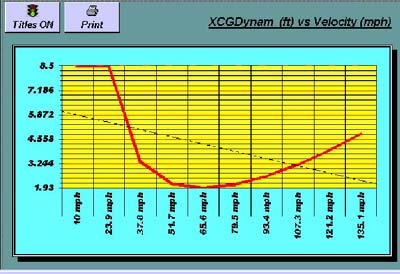Acceleration & Blowover
There is alot going on with respect to the movement of what I call the 'dynamic center of gravity', while a tunnel boat is accelerating out of a low speed turn. The sponsons are likely to be fully wetted, and there's little aerodynamic lift going on. Consequently, the dynamic CG is quite far forward at the exit of the turn.
On accelerating out of the turn, if the 'wing' design of the hull is configured with it's own center of pressure quite far fore (as many are), then there will be some very dramatic movement of the dynamic CG as the boat velocity increases. Typically, in such cases, the dynamic CG moves aft very quickly, and then can actually begin moving fore again. This is very difficult to react to when you're sitting in the boat - let alone at the RC controls 100 yards away!
You can see a typical movement of the dynamic CG on a tunnel boat, as it accelerates out of a low speed turn...

[SIZE=8pt](based on Tunnel Boat Design software, Version 6.5)[/SIZE]
As the velocity increases under these circumstances, the angle of attack of the hull actually needs to be REDUCED, to respond to the rapid change of dynamic CG.
The best alternative is to design the hull and setup for the particular instances of good cornering, and good acceleration out of the corner. Designing for a controlled dynamic CG is alot easier when the balance of these forces is understood for your particular boat and application.
/Jimboat
There is alot going on with respect to the movement of what I call the 'dynamic center of gravity', while a tunnel boat is accelerating out of a low speed turn. The sponsons are likely to be fully wetted, and there's little aerodynamic lift going on. Consequently, the dynamic CG is quite far forward at the exit of the turn.
On accelerating out of the turn, if the 'wing' design of the hull is configured with it's own center of pressure quite far fore (as many are), then there will be some very dramatic movement of the dynamic CG as the boat velocity increases. Typically, in such cases, the dynamic CG moves aft very quickly, and then can actually begin moving fore again. This is very difficult to react to when you're sitting in the boat - let alone at the RC controls 100 yards away!
You can see a typical movement of the dynamic CG on a tunnel boat, as it accelerates out of a low speed turn...

[SIZE=8pt](based on Tunnel Boat Design software, Version 6.5)[/SIZE]
As the velocity increases under these circumstances, the angle of attack of the hull actually needs to be REDUCED, to respond to the rapid change of dynamic CG.
The best alternative is to design the hull and setup for the particular instances of good cornering, and good acceleration out of the corner. Designing for a controlled dynamic CG is alot easier when the balance of these forces is understood for your particular boat and application.
/Jimboat



